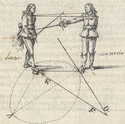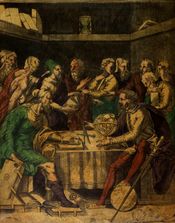|
|
You are not currently logged in. Are you accessing the unsecure (http) portal? Click here to switch to the secure portal. |
Difference between revisions of "Pedro de Heredia"
| Line 763: | Line 763: | ||
| <p>'''Article 21'''</p> | | <p>'''Article 21'''</p> | ||
| − | <p></p> | + | <p>Finding your enemy in third or fourth, you can from the same guard, extend your point below the enemy's guard; then collecting your point a bit above, you will gain the middle of his weak inward from the middle of your strong; and when the enemy goes to press against you, you will disengage below his guard outward to the right shoulder passing with the left foot.</p> |
| | | | ||
| Line 770: | Line 770: | ||
| <p>'''Article 22'''</p> | | <p>'''Article 22'''</p> | ||
| − | <p></p> | + | <p>If you go into third to cover the enemy's sword at his weak and when failing your intention, he disengages his point to shoot a low-thrust from second to your right shoulder, you will quickly twist your hand into a low-thrust and thus, leaning the body and the head, you will push from second the same low-thrust to the enemy's right side; and having anticipated him, you will retire in second.</p> |
| | | | ||
Revision as of 01:37, 19 June 2022
| Pedro de Heredia | |
|---|---|
| Spouse(s) | unknown |
| Occupation |
|
| Nationality | Spanish |
| Movement |
|
| Influences | Girolamo Cavalcabo |
| Genres | Fencing manual |
| Language | Middle French |
| Notable work(s) | Book of Lessons |
| Principal manuscript(s) |
|
Pedro de Heredia was a 17th century Spanish governor of a region in Belgium and a cavalry captain from 1615-1645. He wrote three manuscripts.
De Heredia's Le Livre des Leçons ("The Book of Lessons") is influenced by Girolamo Cavalcabo's Nobilissimo discorso intorno il schermo ("Most Noble Discourse on Defense").
Contents
- 1 Treatises
- 1.1 Preface
- 1.2 Single Sword Play
- 1.2.1 Chapter 1 - Simple lessons of the single sword.
- 1.2.2 Chapter 2 - The discard[9].
- 1.2.3 Chapter 3 - Double lessons of the single sword.
- 1.2.4 Chapter 4 - Feints.
- 1.2.5 Chapter 5 - Voids[10] and remedies.
- 1.2.6 Chapter 6 - The passings.
- 1.2.7 Chapter 7 - Times and counter-times.
- 1.2.8 Chapter 8 - Lessons on sword attack.
- 1.2.9 Chapter 9 - On the use of the free hand.
- 1.2.10 Chapter 10 - On sword-taking and its remedy.
- 1.2.11 Chapter 11 - The gainings[11] or the subjections of the sword.
- 1.2.12 Chapter 12 - Slashes[12], reversals, and their remedies.
- 1.2.13 Chapter 13 - Single sword play in mathematics form.
- 1.2.14 Chapter 14 - Discourse and advice of the single sword play, both for winning land and other required subtleties.
- 1.2.15 Chapter 15 - Rule to avoid being surprised on the time of the foot.
- 1.2.16 Chapter 16 - Single sword play against sword and dagger.
- 1.2.17 Chapter 17 - On the short sword.
- 1.2.18 Chapter 18 - On the use of the cloak.
- 1.2.19 Chapter 19 - The grapples of the single sword.
- 1.2.20 Chapter 20 - Against the left-hander.
- 1.3 Sword and Dagger Play
- 1.3.1 Chapter 1 - First the dagger parries.
- 1.3.2 Chapter 2 - The simple lessons of sword and dagger.
- 1.3.3 Chapter 3 - The feints of the said sword and dagger play.
- 1.3.4 Chapter 4 - On the beats of both sword and dagger.
- 1.3.5 Chapter 5 - On the long play.
- 1.3.6 Chapter 6 - The double intentions.
- 1.3.7 Chapter 7 - The passes and their remedies.
- 1.3.8 Chapter 8 - The disappearances.
- 1.3.9 Chapter 9 - On times and counter-time.
- 1.3.10 Chapter 10 - The encroachment.
- 1.3.11 Chapter 11 - The advancing[13] on the long and short play.
- 1.3.12 Chapter 12 - On the breaking.[14]
- 1.3.13 Chapter 13 - The slashes of the sword and dagger play.
- 1.3.14 Chapter 14 - Binding and unbinding.
- 1.3.15 Chapter 15 - Subjugation, disengagement, and avoidance of engagement.
- 1.3.16 Chapter 16 - Lessons of dagger cuts.
- 1.3.17 Chapter 17 - How one can throw the sword out of the hand.
- 1.3.18 Chapter 18 - On the left foot.
- 1.3.19 Chapter 19 - Against the left-hander.
- 1.3.20 Chapter 20 - Discourse and advice of the sword and dagger play.
- 1.3.21 Chapter 21 - Know who has more advantage being in a mountainous place, he who holds the top or the bottom.
- 1.3.22 Chapter 22 - Know who has more advantage, the left-hander or the right-hander.
- 1.3.23 Chapter 23 - Rule against those withdrawing that we want to catch off guard while you pursue.
- 1.3.24 Chapter 24 - Know who has more advantage, the sword and cape or the sword and dagger.
- 1.3.25 Chapter 25 - Advice on how a little man needs to control a big man.
- 1.3.26 Chapter 26 - The grapples of the sword and dagger.
- 1.3.27 Chapter 27 - The guard takes against dagger cuts.
- 1.4 Copyright and License Summary
- 2 Additional Resources
- 3 References
Treatises
Illustrations |
Transcribed by | |
|---|---|---|
| The strong will be from the back half for defense. And the weak for offense from the point until the middle.
The sword can also be divided into three as you see above. As for the guards on which I rest my foundation, I stand with the common opinion of those who have made a profession of handling arms well that there are four guards, in the order that they are consecutively attributed; which nevertheless can be reduced to two, joining the first and second in one, and the third and fourth in the other. So let's say before going over what it is to be perfectly on guard. To be on guard consists of two things, namely: the accommodation of the body and that of the sword. |
||
| Section 1 - How one must accommodate the body to get into a good posture.
Now the accommodation of the body to be on guard will be holding the body straight with the right side a bit forward, turning the left side a bit backward, leaning the body on the left leg, of which the knee must be bent; the left arm is raised near the face like a semi-circle, the right leg extended or slightly bent, the two heels face-to-face to one another showing only the flank; you will cover with your right arm well extended below and a bit in front above the right thigh, the sword point looking in front of the enemy's right shoulder a bit higher than the fittings[1], and traversed somewhat inward, properly going on all sides to the enemy's sword. It is the third guard that I hold to be the most perfect, and in which all observations of good technique can be better preserved, since everything that derives from the other guards can easily (at least in part) be accommodated by this one. However having previously spoken of the four guards, I want to explain each of them in their place, to show that it is not necessary to rest in only one, because I hold them all good when performed well. Before putting the said guards in effect, a good master must teach his disciples the steps which are called passing, turning, traversing, and linear following before putting the sword in their hand, to make them more agile and swift in all movements, which having understood, he will give them sword in hand, teaching them the ensuing guards from which all the others derive as their principal element. |
||
| Section 2 - The four principle guards of the single sword.
Article 1 The first guard is when one holds the arm at shoulder height. Article 2 The second will be when the hand is a bit lower than the shoulder. Article 3 The third is when the arm is a bit forward past the knee as it has been said above. Article 4 The fourth will be holding the sword forward from the left side. |
||
| Section 3 - Counterguards to the aforementioned.
The counterguard of the aforementioned first will be the fourth guard. The counterguard of the second will be the same. The counterguard of the third will likewise be the same in passing outward from the enemy's sword. The counterguard of the fourth will be the third, your sword covering that of the enemy's with your strong on your opponent's weak. |
||
Section 4 - It is also important to know how our body can operate. Our body can be divided in two parts, one for offense, the other for defense. The right part will be used for offense, and the left for defense. |
||
Section 5 - The most notable points of advice that must be observed in several places. First, note when you are on guard with the enemy that you have a view of his eye, so that you have the proper means to discover all of his intentions. If you see the enemy's foot narrow, it will be to offend, if it is wide it will be to wait. |
||
Section 6 - Knowing which is the sword's correct[2] or false edge. The sword's correct edge is that which offends and the false edge is that which parries. |
||
Section 7 - Four ways of passing. The first passing is made outward from the enemy's sword. The second will be on the left side, the third will be narrowing the step going in a straight line. The fourth will pass one foot in front of the other; take heed that with this last passing, the left foot must move first. |
||
Section 8 - Knowing which are the kind of times. Time of the sword, time of the foot, and time of the body movement are those that one can take in measure, when one wants to offend his enemy. |
||
Section 9 - Which kind are being in and out of measure. The measure consists of the distance from which one can reach each other with a single extended step, for there are three kinds, namely: exact, narrow, and far measure. The exact measure is when one can reach one another in one step, the narrow measure is when one can reach one another solely by extending the sword or an unforced half-step. The far measure is when one cannot easily reach with only one step; so to perfect it, we put a half step forward with a forced follow-up, another step to reach at what is the true resolute cut. Out of measure means when one cannot reach one another. |
||
Section 10 - How to win the measure. The measure, whatever it is, is gained by four kinds of accommodation of the foot which are called: advancing, approaching, joining, and chasing of the foot. The advancing of the foot is when, being in narrow or true step, you gain the measure advancing the right foot forward to double again with the right foot or go with the left foot as you see fit. The approaching of the foot is when, finding yourself in a wide step, you approach your left foot halfway to go to the right, then after with your right foot. Joining is when, finding yourself in true or narrow step, you join your left foot to the right to have means of advancing the right foot. The chasing of the foot is when, finding yourself in wide step, you approach with the left foot and chase the right further forward than it was. It is also curious to note and observe, before any accommodation of foot, to advance the sword a bit towards the enemy's weak and to have an eye on the lookout so as not to be caught by surprise, and that you can go in countertimes to your advantage. I in no way approve of the stamping of the feet being an improper and uncomfortable thing. As also I entirely blame those who shoot their high-thrust, stretch their bodies and hold their heads back, thinking that this makes a better cut, in which they are mistaken. On the contrary, they more often than not abandon themselves to the discretion of their enemy, for they are not assured of delivering their cut, which having just been parried, they find themselves so rushed and so committed that they cannot recover time without receiving. Also, it removes the protection of the left hand; therefore I cannot approve of these big steps, and I say that it is better to hold the body straight with strength by extending his cuts to be always prompt in the delivery. |
||
Section 11 - What is the strong and the weak of the sword. The strong will be for defense, from the back half; and weak for offense from point until the middle. |
||
Section 12 - Understanding when one is on guard with advantage. The advantage will be when you have the sword point right at the enemy's shoulder, and his sword does not face you. |
||
Section 13 - Some definitions of words that are noted to understand fencing. Pass means to always move without changing intention except when the opportunity arises. Rotate[3] properly speaking means going or twisting towards the part that one wants to offend whether it is inward or outward. Step means going step by step both forward and backward. Collect the foot means to bring the foot back to therefore break the measure with discretion. High-thrust[4] means a touch given with the point carried by the hand twisted with the nails upwards. Low-thrust[5] also means a touch with the point taken with the hand twisted with the nails downwards. A stab means a touch both in low-thrust and high-thrust. Disengage[6] means when one feints high and goes low, or feints low and goes high. Call means pulling a step or uncovering a part of the body, to provoke the enemy to attack, in order to execute what one desires. Firm foot means to give a long high-thrust or low-thrust without passing. Riposte is the high-thrust that the enemy shoots at he who shot first, whether a thrust or a hew. Straight line is to pursue the enemy without rotating or crossing anywhere. Dodge the body means to twist it to give way to the high-thrust that the enemy shoots. Round outers[7], and round reversals mean hitting with a reversal and with a hew without moving the hand from where it is except by twisting it. Hew the sword is to beat the enemy's sword with one's own. Cover the sword means to extend your sword onto that of the enemy's to subdue him or to compel him to disengage. Puncture the sword is to force the enemy to change guard. Sometimes if one is said to shoot a stab to the face or a cut to the head, that may be a feint, therefore, one must use discretion. Beating of the foot means feinting to push a resolute high-thrust with firm foot so that the enemy must parry and after he does to redouble to another where you will see him open. Flourish means to vary your point below the enemy's sword, both outward and inward, so that the enemy cannot know your intention, nor cover your sword. Recover or return in first, second, third, or fourth means to retire on guard with order. |
||
For further information, including transcription and translation notes, see the discussion page.
| Work | Author(s) | Source | License |
|---|---|---|---|
| Illustrations | |||
| Transcription | Lionel Lauvernay, Olivier Dupuis, Philippe Errard, Didier de Grenier | Livre des Lecons |
Additional Resources
References
- ↑ According to Lauvernay, fourniment is the powder case of arquebusiers and musketeers (sometimes extended to all the equipment carried). The word is only used once to indicate a place on the body, probably a bit below the shoulder.
- ↑ Droit can mean "right" or "correct" (as in not incorrect) or "true".
- ↑ Volter is an Italian loanword of voltare which means "to turn".
- ↑ Estocade is the French loanword for the Italian stoccata and is used in this treatise as "supination".
- ↑ Brocade is the French loanword for the Italian imbroccata and is used in this treatise as "pronation".
- ↑ Caver is the French loanword for the Italian cavare, which means "to dig or to excavate".
- ↑ Lit. translated as "right-hands".
- ↑ Estramaçon is a loanword for the Italian stramazzare which means "to fall heavily". It is also French for greatsword.
- ↑ Credits to Alan Bloniarz for providing context to the word "garatusa" which is a Spanish card game where one discards their cards to win.
- ↑ Écarté is the French loanword for the Italian technique "inquartata" and means "discarded"
- ↑ Gannance is a loanword derived from the Spanish word "ganancia", which means "gain". It is used to describe a situation where your blade is used to restrict the opponent's blade movement. Credit to Tim Riviera for the explanation.
- ↑ The Spanish word "cortar" simply means "to cut".
- ↑ Chassement means "chasing". In this case, it is the back foot chasing the front. In modern fencing, this is known as advancing.
- ↑ Crèvement means "to burst or to puncture." In the treatise, it is used to describe breaking guards.
|
|||||||||||||||||||||||||||


